by Editor | Sep 28, 2015 | Attractions, New Articles
Photos by Aaron Lubarksy

An advertisement for the Whitney on the stairs of the New York City subway
Earlier this year, the Whitney Museum of American Art opened its new location in the Manhattan Meatpacking District. Our contributors visited the museum and liked the building, which they considered a work of art in itself, and its contemporary art collection.

A sculpture on one of the Whitney’s terraces
They saw famous paintings by contemporary artists Edward Hopper, Willem De Kooning, Barbara Kruger, and Jean-Michel Basquiat. They also appreciated the surrounding neighborhood full of markets, restaurants and views, and took advantage of their visit to explore the area near the building.
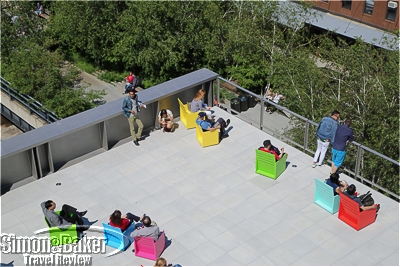
A site-specific exhibit by Mary Heilmann on the largest outdoor gallery at the museum
by Editor | Aug 10, 2015 | Ecotourism, New Articles
By Elena del Valle and photos by Gary Cox
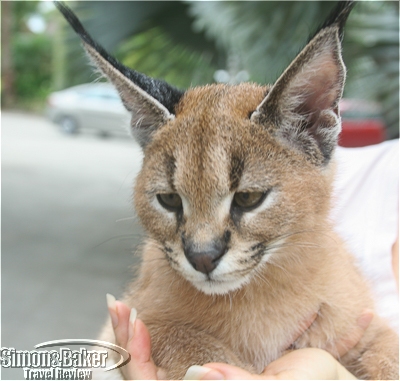
Freya, a caracal lynx
As I stood near a lion themed water fountain in a subtropical garden at the Zoological Wildlife Foundation in the southwestern suburbs of Miami, Florida holding Freya, a relaxed caracal lynx, an African khaki colored wild cat with pointy ears, I marveled and took a mental snap shot of the special moment. Never in the many safari drives and walks I have been fortunate enough to enjoy over the years had I come close to the elusive bush animal. Freya allowed me to pet its head and back. I was surprised at how soft the fur felt and how comfortable Freya was settled in my arms.

Vadim, a rare amur leopard
Sure, the caracal’s attention span was fleeting. It turned left toward a group of visitors near the monkey cages and right as the sounds of nearby construction drew its attention. Yet it was calm, allowing me to savor the experience while my partner struggled to photograph it because while its body remained immobile its head swiveled around constantly. It was curious and distracted, making it difficult to capture even a single clear image.

Mario Trabaue holding Onyx, a restless black jaguar
Next, we had a chance to hold Onyx, a young black jaguar. Despite the clouded midday sky we could see the muted rosettes on his black coat. They were stunning. Freya seemed downright angelic in comparison to the gorgeous jaguar who would not be still, not even in the arms of its expert handler. After a few moments of intense and futile wrangling I passed Onyx back to him. He had little more luck than I did. Eventually it was my travel partner’s turn to hold the cat. When for an instant Onyx calmed down I lifted the camera to take photos until my partner yelped. The reason the cat had seemed less agitated was because it was defecating and the excrement landed on his arm. The incident did nothing to dampen our enthusiasm. He cleaned his arm as best as he could with the chilled iced tea bottle we had at hand while we watched Onyx leave in the company of its owners, Maria C. Tabraue and Mario Trabaue, who had come to greet us during our Zoological Wildlife Foundation Private Tour with a primate and feline interaction session.

Sarabi, a playful tiger cub
Stephen Gregorio, our friendly guide and the Foundation’s zookeeper, had Vadim, a rare amur leopard, on a leash a few feet away from us. They had been standing there during our interaction with Onyx. Vadim too returned to his enclosure shortly after Onyx. In the interim, we awaited the arrival of Sarabi, an adorable tiger cub. We could not get enough of him. He acted like the aloof celebrity he was, gently biting his handler’s pants, pouncing on plants, and stalking invisible prey. We also spent quality time with Amorette, a capuchin monkey, and after her Chung, a gibbon. Curious and playful she arrived with a stuffed companion and was relatively calm in my arms. Chung, on the other hand, wouldn’t hold still for a moment, and was desperate to flee and explore on his own.

Stephen Gregorio, zookeeper at the Foundation, and Amorette, a capuchin monkey
Many of the non human inhabitants of the Foundation were born there (50 percent of the babies had been born and remained at the facility) or transferred from Zoological Association of America accredited facilities. Some were rescues from people who could no longer house them while others had been seized from owners without permits or wildlife violators. Still others had been abandoned, injured or brought for rehabilitation. Whenever possible the Foundation released rehabilitated animals, a spokesperson explained.

Chung, a gibbon, wanted to explore
The five-acre facility welcomed approximately 20,000 visitors per year. While we awaited our tour guide in the check-in arrival area we heard several foreign languages. It was no surprise since slightly more than half of the visitors were from out of the state or the country. I imagined the intimate wildlife experience drew many of the tourists from near, like us, and far away. According to a 2014 article by Sharon Guynup in NationalGeographic.com only 3,000 tigers may remain in the wild.
According to WildLifeConservationSociety.com only 25 to 40 amur leopards remain in the wild. During our visit to the Foundation we saw a tiger and an amur leopard. They were clean and appeared to be well looked after by the staff. While my preference remains to see wildlife in its natural habitat, in those cases where the animals may no longer survive and thrive in the wild a captive environment may be the only alternative. The Foundation provided a home for its animal residents and an opportunity for visitors to support the upkeep of the animals and at the same time visit them. It was a memorable experience worth repeating.
by Editor | Jul 27, 2015 | Ecotourism, Luxury Travel, New Articles
Article and photos by Josette King

The Gulf of Corinth
I thought I knew Greece. I had visited a couple of its legendary islands and snorkeled in the crystalline waters of its rocky coves. I had stayed in Athens long enough to explore most of its nearby ancient ruins. I had enjoyed the taverna food and the street musicians playing their ornate nine-string bouzouki. And I had learned to stay clear of ouzo, the fiery local brew. So, yes I thought I knew Greece. Until I came across an eight-day Tripology Adventures itinerary from Athens to the Pindus Mountains with overnight stops in Delphi, Ano Chora, Karpenisi, Kalampaka and back to Athens.

Columns of the temple of Apollo in Delphi
Tripology is an adventure travel company that has been leading self-drive caravans of all-wheel drive vehicles into remote history-rich areas of the planet for over two decades. The Pindus Mountain Range, the vast backbone of peaks, valleys and gorges that traverses the Greek mainland from the northwest to the southeast definitely fit that profile. It is covered with forests so impenetrable that its central region, the Agrafa (Greek for unchartered), succeeded in maintaining its autonomy throughout the four centuries of Ottoman occupation of the country, becoming a refuge for the fiercely independent souls who wanted to escape the oppressors. That wild, sparsely inhabited region has remained relatively pristine to this day. Most of the roads that wind their way up and down its steep slopes are still unpaved. That was a unique opportunity to venture on terrains that I knew better than to attempt on my own and explore a Greece I hadn’t realized still existed.

Statuary from the Delphi Archeological site now on display in its museum
Our five-vehicle convoy left Athens on a sunny spring morning, four late model 4 x 4 vehicles packed with eager adventurers, 14 of us in all, following the lead land cruiser with our guide, Yoav Barashi, a seven year veteran of Tripology tours in the area. Our lead driver Nikos Manolis, an expert all terrains driver, was also a noted figure in the Greek rally community. The highlights of the first day, a relaxed seaside lunch on the Gulf of Corinth and a privately guided tour of the archeological site of Delphi, were a pleasant nod to familiar Greece, and an ideal opportunity for us to get acquainted with our traveling companions and our vehicles.

Tiny roadside shrines were a frequent sight
The next morning, the roller-coaster ride that was to become the norm for our entire 1,200 kilometer trip began in earnest as we negotiated Bauxite Way. The 24 kilometer (15 mile) uphill strip of gravel and tight turns is one of the best known stages of the Acropolis Rally of Greece, named after the nearby aluminum ore mine and the prevalent red dust. After the exhilarating driving experience followed by a break at the shaded terrace of a village taverna, we were on our way again. That time we climbed up a rough unpaved trail that hugged the rock face and curved incessantly upon itself on our way to a mountaintop picnic. Our lunch scenery was a jaw-dropping view of densely forested canyons and craggy peaks. Then after an equally tortuous descent we ended up at a rustic village inn for the night.

Lake Mornos
Day after day, as we drove deeper into the Pindus and entered the Agrafa area, the mountains became higher, the canyon deeper and the trails hewed out of the rock more forbidding. Those dramatic vistas bursting with the colors of spring were a photographer’s paradise. Each turn revealed a better view of snow capped peaks, a turquoise lake sculpted by canyons in the shape of a giant octopus or a hill dotted with the purple blooms of Judas trees. Tiny roadside shrines were a frequent sight, presumably meant to petition for divine protection on behalf of intrepid travelers or offer thanks for road catastrophes avoided as much as to mark the spot of one that had been.
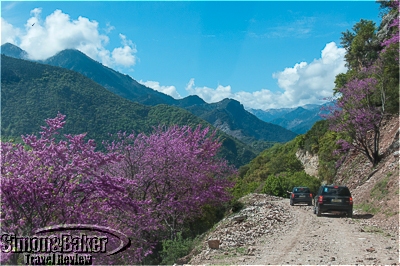
The mountain roads were lined with Judas trees in full bloom
We could drive for hours without seeing a sign of human life, much less another car. Then a shepherd with his flock of long haired sheep appeared, or a herd of goats plundering the high grass at the edge of road or beekeepers tending their hives. One more bend in the road would reveal a village of sturdy stone houses stacked against the mountain, and blending into the rock. We would stop in the central platia, the village square at the heart of every Greek village bookended by the ubiquitous taverna on one side and the village church on the other. Even the smallest of churches was a treasure trove of gilded icons and byzantine style frescoes.

Cemetery on the shore of Lake Kremaston
Our guide Yoav was remarkable for his extensive knowledge of the region and also for his passionate interest in it, which he shared over our two way radio channel. He brought places and events into human context, shedding light on a vibrant and often tragic history that is little more than a footnote in western history books. He was equally knowledgeable of the tales of Greek mythology, mimicking to great effect the foibles of Zeus, Apollo, Hermes and even Aphrodite or Psyche. Had my high school history teacher possessed a fraction of his story telling talent, I might have been an ancient Greece scholar today.

Villages were stacked against the hillsides
Do I know Greece now? I do, a little better at least. But more importantly, thanks to this road journey, I fell in love with the country. I now yearn to return at the first opportunity. And best of all, I so enjoyed the Tripology Adventures way of exploring new horizons that I am already searching their destinations for my next road adventure.
by Editor | Jan 19, 2015 | Attractions, New Articles
Article and photos by Elena del Valle

Our view of the Nevis shore as we sailed toward Saint Kitts
During a recent stay in Nevis, part of Saint Kitts and Nevis in the Caribbean, I went on a relaxing three-hour morning sailing activity aboard the Caona, a pretty catamaran owned and operated by Leeward Islands Charters (Fort Street, P.O. Box 586, Basseterre, Saint Kitts, +869-465-7474, fax 869-465-7070, www.leewardislandscharters.com, sail@leewardislandscharters.com). The weather had been mixed due to regional storms and I wondered if the outing would be cancelled. Luckily, on the day of the activity, the weather was good and there was a slight breeze.

From the sailboat we saw Mount Nevis and the shoreline – click to enlarge.
From the Montpelier Hotel and Beach, a pretty and secluded hillside hotel on the other side of the island where I was staying, I made my way to the Four Seasons Hotel in time for our 11 a.m. departure. Crossing from the parking lot to the dock I was pleased when I sighted the Caona. The sailboat, made in Saint Kitts in 1985, was 47 feet long by 22 feet wide and had a maximum capacity of 24 passengers on the Nevis Sail & Snorkel activity. A friendly man with an island accent and a clipboard welcomed me, asking right away if I was staying at the Four Seasons Hotel where the boat had docked and everyone else was staying. I assumed he wanted to know what room to charge.

A beautiful day for sailing
I shared the boat with three couples, all Four Seasons guests visiting from the United States. Once we boarded the vessel, Lennox Wallace, our friendly captain, introduced himself and Elvis Richardson, his first mate; told us about the boat and its amenities, and what we would be doing.
At first we all sat in the shade next to the captain, getting to know each other and gazing curiously at the receding Nevis shore as we made our way slowly toward Saint Kitts. The sun felt warm and pleasant on my skin. Puffy white clouds peppered the cerulean Caribbean sky in a picture perfect moment. A mild breeze and the sound of splashing as we glided gently over the water completed the scene. The boat swayed with the gentle surf as we cut a line across the Caribbean waters in a westerly direction.

Lennox Wallace, our captain, at the helm
After spraying liberal quantities of sunblock, the captain had warned us to sunblock was essential, I carefully made my way forward. I sat down on the deck, bringing one of the many towels available with me in case the surface was hot (it was cool to the touch). Soon the couples also all made their way to the same area of the boat. Elvis brought us cold drinks. The choices were rum punch, beer, soft drinks and water. We chatted amongst us, exchanging pleasantries until the rhythmic lull of the boat soothed us into a companionable silence.

We snorkeled in clean turquoise water in Shitten Bay, Saint Kitts – click to enlarge
Before long we reached Shitten Bay, a calm cove in Saint Kitts where the crew anchored with ease. Although there had been a boat when we arrived, it departed within moments, leaving us in the privacy of our temporary shelter. We sighted a turtle before we had even settled in our new spot. While Elvis sorted out snorkeling gear for each of us the captain instructed us on the snorkeling site and safety procedures. Like the boat itself the snorkeling equipment was clean and smell free. I was delighted to discover they had fins and a mask that fit me.

Our catamaran was 47 feet long and 22 feet wide and could accommodate up to 24 passengers.
Within minutes of arriving we were all scattered in the warm water admiring the sea life below the surface.
Colorful tropical fish swam up to twenty feet below in a bed of rocks peppered with a few young coral. Slowly we each came back, climbed the ladder and dried off the salt water. After we all returned to the boat and settled down we headed back to our island. A short sail later we arrived back in Nevis, smiling. At the dock we all said our good-byes and headed back to our respective plans for the day. I sighed contentedly. The morning of pleasant sailing shared with a handful of equally pleasant people, and snorkeling in turquoise warm waters had left me with an irie feeling. That carefree sense was why I had gone to Nevis.
by Editor | Nov 3, 2014 | Accomodations, New Articles
Article and photos by Josette King

The formal arched central entrance of Keswick Hall
It is not unusual for friends who know that I am “always running off somewhere” to ask about my personal “short list” of favorite properties around the world; and be surprised that the list is quite short, of properties so exceptional in their location, surrounding, facilities, accommodations and service that I would gladly fly half way around the world to enjoy them again. On my recent visit to Charlottesville, Virginia I had the pleasure of adding one entry to my list, Keswick Hall.

The infinity swimming pool acted as a reflecting pool for the north facade of the villa
The elegant Italianate mansion located on 600 acres (243 hectares) of pristine countryside at the eastern edge of the city had the feel of a grand English country estate. As I drove around the circular driveway to the formal triple archway of the central entrance, I fleetingly wondered whether the walking shoes and jeans in which I had roamed all day from area wineries to remote artist studios were appropriate for the occasion. But already, the doorman was making me welcome like a long expected friend of the family. My luggage was out the trunk and my dusty rented car whisked away by the time I stepped through the open door into my “great uncle’s country mansion.”

My room was a welcoming retreat of understated elegance
It was just as Sir Bernard Ashley intended when in 1991 he set out to transform the decaying Italianate Villa Crawford into a world class property where guests would feel they were staying at a private manor house. Three years and a $25 million major restoration and expansion effort later, he had created Keswick Hall.
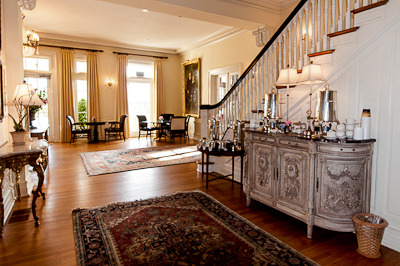
The historic North Wing had reclaimed its original opulence
In the central grand entrance hall, mellow oriental rugs created intimate spaces for clusters of inviting sofas, armchairs and antique accents furniture. Fresh flowers, in seemingly simple arrangement hinted at having been brought from the garden on a whim by an artistically minded lady of the house.
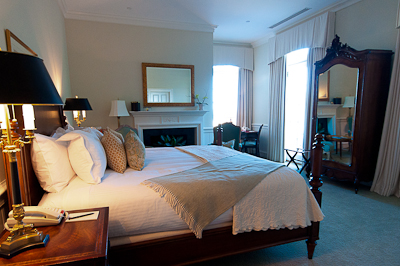
An antique mirrored armoire was a focal point of my room
In spite of its vast proportions, the room had a lived in feel, as though it had organically developed to its current gracious state through generations of residents. I had to remind myself to look for the reception area. It was there, an inconspicuous desk in the corner nearest to the entrance, as was the concierge desk, in the opposing corner of the hall. Both were staffed with knowledgeable and attentive hosts who appeared ready to assist with even the smallest of wishes. This was the norm for any staff member with whom I came in contact.

The North Wing sitting room
My own accommodations were equally welcoming, a large light filled room decorated in a relaxing neutral palette and a mix of antiques and period inspired furniture, and a French door that opened onto a large corner terrace with views of the garden and the manicured vistas of the golf course. Fossett’s, the property’s award winning restaurant, was remarkable not only for the quality of its classic continental cuisine with Virginia flair, but for it panoramic views of the estate’s rolling hills and the Blue Ridge Mountains beyond.

The lower terrace of the mansion reached out the rolling lawns at the rear of the estate
In addition to its flawless hospitably, Keswick Hall offered activities to indulge the most varied tastes, from the billiard room restored in the original Villa Crawford, now the Historic North Wing of the mansion, to an in-house spa, a croquet pitch overlooking the Southwest Mountains, spectacular 18 hole golf course, nature walk and bird watching trails, aquatic center and tennis courts. It even had its own courtside vineyard. But for me, the ultimate luxury was the Horizon Pool, the adults only, heated saltwater infinity pool that reflected the north façade of the mansion. Best of all, it was open around the clock.
by Editor | Oct 6, 2014 | New Articles, Restaurants
Article and photos by Josette King

The restaurant was located on the first floor of the Clifton Inn
During my recent visit to Charlottesville, Virginia I had the pleasure to dine at the Clifton Inn Restaurant. My reservation, made ahead by a local friend, indicated that it was for the Chef’s Counter. I didn’t realize the extent of my good fortune until I was escorted through the dining room, straight to the kitchen. As the daughter of a French chef, I have appreciated since childhood that it is a singular privilege to be invited into the inner sanctum. And that night, I was the chosen one.
I was momentarily perplexed by the long row of copper pans, much too perfectly shined to have seen recent service, lined against a coral accent wall, and the gilded mirror at the far end of the room, strategically placed to reflect the crystal chandelier that hung over the pale polished concrete counter. But then I hoisted myself onto a comfortable bar chair, and across the countertop, had a panoramic view of the kitchen.

The Chef’s Counter provided a front row view of the action in the kitchen
It was equipped with the latest in high end professional equipment and had a traffic pattern designed for maximum efficiency. It clearly meant business. As did Tucker Yoder, the executive chef, and his capable team.
Everyone was calm, focused on the task of the moment, every gesture precise as they created one remarkable dish after another. And yet they were sufficiently relaxed to engage in conversation with me about anything from the unusual pairings of textures and flavors on my plate or the culinary journey that had led them to the Clifton to the ethos of the farm to table movement.

Chef Yoder, sous chef Jared Adams and pastry chef Kristen Johnson focused on their creations
It was a creative group of professionals who, under the guidance of Chef Yoder, delighted in pushing the boundaries of classic cuisine, and experimenting with ingredients and techniques to bring gastronomy into the 21 century, except when timeless tradition still delivered the best results. They churned their own butter, made sourdough bread from a three year old starter and kept a kitchen garden (right outside the kitchen door).
At the Chef’s Counter, guests had the option to choose from the restaurant’s menu or the tasting menu. I opted for the latter and what followed was two hours of bite size delights and discoveries.

Ham and pea salad with chervil
“What is this?” I had to ask of the crisp leaf shaped wafer under the creamy dollop of pureed apple and fennel of my amuse bouche. Jared Adams, sous chef, who was working nearest to me at the moment, volunteered that it was dehydrated ramp, a sort of local wild leek. And by the way, they foraged it.
Several dishes later came the field greens salad, fresh from the garden; so fresh there was a spoonful of garden dirt on the plate. That time Kristen Johnson, pastry chef, answered, “just black cocoa powder, butter and sugar, lightly baked then finely crumbled.”

Sticky pudding with date puree, candied pecans and caramel ice cream
We have come a long way since garlic croutons. If pressed to identify a favorite dish, a hard decision, I probably would have singled out the succulent grit encrusted oysters with their garnish of sautéed wild mushroom, served over pureed apples with brown butter. But that’s because I hadn’t yet factored in dessert. I had challenged Kristen to surprise me with “her most Virginian dessert.” That turned out to be a divine sticky pudding with date puree, candied pecans and caramel ice cream. Even after so many dishes (I had lost count long before the end of the meal), I cleaned my plate. At Chef Yoder’s Counter, excess was a wonderful thing.











































